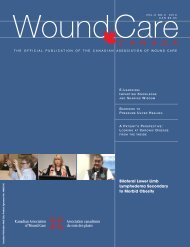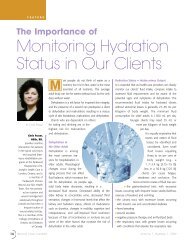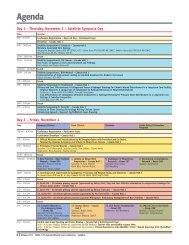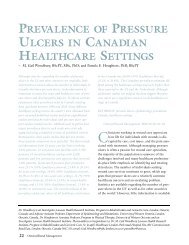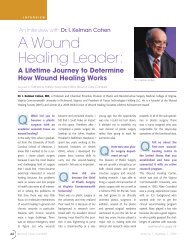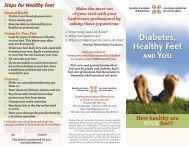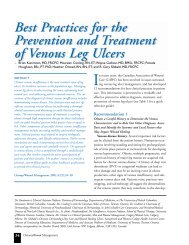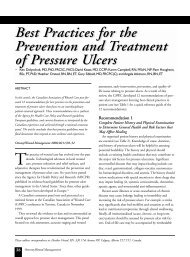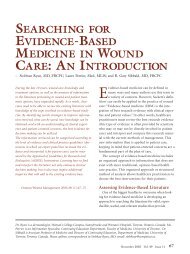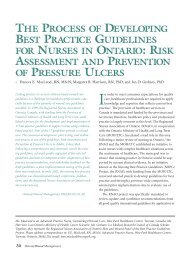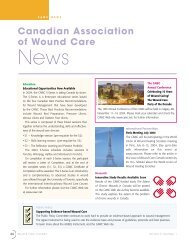Inlow's 60-Second Diabetic Foot Screen Tool
Inlow's 60-Second Diabetic Foot Screen Tool
Inlow's 60-Second Diabetic Foot Screen Tool
Create successful ePaper yourself
Turn your PDF publications into a flip-book with our unique Google optimized e-Paper software.
Interpreting Results<br />
Inlow’s <strong>60</strong>-second <strong>Diabetic</strong> <strong>Foot</strong> <strong>Screen</strong> has been designed to allow the clinician to screen persons with diabetes to prevent or treat diabetes-related foot<br />
ulcers and/or limb-threatening complications. By combining the results from different parameters identified with Inlow’s <strong>60</strong>-second <strong>Diabetic</strong> <strong>Foot</strong> <strong>Screen</strong>,<br />
the clinician can identify pathologies and/or care deficits.<br />
Parameters<br />
1 2 3 4 5 6 7 8 9 10 11 12<br />
Indications<br />
Self Care Parameters:<br />
High scores in parameters 1, 2 and 4 indicative of self care deficit.<br />
Integument Parameters:<br />
Moderate scores in parameters 4 and 7 indicative of callous formation.<br />
High scores in parameters 1, 6 and 12 indicative of infected ulcer.<br />
High scores in parameters 2, 6 and 12 indicative of infected nails.<br />
Arterial Flow Parameters:<br />
High scores in parameters 5, 10 and 11 indicative of peripheral arterial disease.<br />
Sensation Parameters:<br />
High scores in parameters 8 and 9 indicative of loss of protective sensation or neuropathy.<br />
Boney Changes Parameters:<br />
High scores in parameters 3, 8 and 9 indicative of Charcot changes.<br />
Determining Risk<br />
Inlow’s <strong>60</strong>-second <strong>Diabetic</strong> <strong>Foot</strong> <strong>Screen</strong> can also assist in determining patient risk. By reviewing the results from Inlow’s <strong>60</strong>-second <strong>Diabetic</strong> <strong>Foot</strong> <strong>Screen</strong>,<br />
the clinician can use the International Working Group on the <strong>Diabetic</strong> <strong>Foot</strong> (IWGDF) – Risk Classification System to identify a risk category for their<br />
patients.<br />
Step 1: Complete Inlow’s <strong>60</strong>-second <strong>Diabetic</strong> <strong>Foot</strong> <strong>Screen</strong> by assessing both feet on every patient with diabetes.<br />
Step 2: Using the IWGDF Risk Classification System, identify which category your patients falls into.<br />
International Working Group on the <strong>Diabetic</strong> <strong>Foot</strong> (IWGDF) –<br />
Risk Classification System (Modified 1 )<br />
Risk<br />
category Criteria<br />
0 Normal – no neuropathy<br />
1 Loss of protective sensation<br />
2a LOPS and deformity<br />
2b Peripheral arterial disease<br />
3a Previous hx of ulceration<br />
3b Previous hx of amputation<br />
1. Lavery LA, Peters EJG, Williams JR, Murdoch JR, Hudson A, Lavery DC. Reevaluating the Way We Classify the <strong>Diabetic</strong> <strong>Foot</strong>. Restructuring the diabetic foot risk classification<br />
system of the International Working Group on the <strong>Diabetic</strong> <strong>Foot</strong>. Diabetes Care 31:154–156, 2008.<br />
Considerations Based on Clinical Settings<br />
1. Acute Care: Due to the high turnover of patients in acute care, clinicians needs to ensure that the initial assessment goes with the patient to their<br />
next level of care.<br />
2. Long Term or Residential Care: Patients with diabetes may have mobility issues and are in bed or wheelchairs. Feet still may become traumatized by<br />
the use of inappropriate footwear even if they are non-weight bearing.<br />
3. Dialysis Unit: Some dialysis units may wish to augment this tool with toe pressures and blood work, depending of their clinical support.<br />
4. Home or Community Care: Clinicians can use this tool for communication with their patients, each other or other departments, such as specialized<br />
clinics.<br />
5. <strong>Foot</strong> Clinic: <strong>Foot</strong> clinic standards of assessment will be at a higher standard. However, this document is a good communication tool with other<br />
clinicians that may be caring for the person with diabetes.<br />
More Information<br />
For more information on the assessment and management of the diabetic foot, refer to:<br />
1. Best Practice Recommendations for the Prevention, Diagnosis and Treatment of <strong>Diabetic</strong> <strong>Foot</strong> Ulcers: Update 2010 at www.cawc.net<br />
2. RNAO Best Practice Guideline Reducing <strong>Foot</strong> Complications for Persons with Diabetes at www.rnao.org<br />
3. RNAO Best Practice Guideline Assessment and Management of <strong>Foot</strong> Ulcers for People with Diabetes at www.rnao.org<br />
4. The International Working Group on the <strong>Diabetic</strong> <strong>Foot</strong> at www.iwgdf.org<br />
5. Diabetes, Healthy Feet and You at www.cawc.net/index.php/public/feet/<br />
3 Adapted from Inlow S. A <strong>60</strong> second foot exam for people with diabetes. Wound Care Canada. 2004;2(2):10-11. · © CAWC 2011 · 101E



